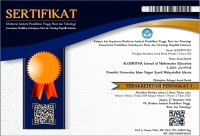FLIPPED CLASSROOM IN MATHEMATICS EDUCATION AFTER PANDEMIC: A SYSTEMATIC LITERATURE REVIEW
Abstract
Abstract
The COVID-19 pandemic has highlighted the need for adaptive learning models, especially in mathematics education. This study aims to analyze publications on the Flipped Classroom model in post-pandemic mathematics education (2021–May 2023) and to explore its future development. The method used is a systematic literature review of 10 articles, consisting of two Scopus-indexed articles and eight articles from Google Scholar obtained using the Publish or Perish application. The total number of participants involved in the reviewed studies is 1,200, comprising 370 elementary school students, 208 junior high school students, 179 senior high school students, and 417 university students. The findings indicate that the digital-based Flipped Classroom model can enhance mathematical communication skills, critical thinking, conceptual understanding, problem-solving abilities, and higher-order thinking. Moreover, it positively influences students' self-confidence, creates a more interactive classroom environment, generates positive learning responses, and supports social interaction in online settings. These results suggest that the Flipped Classroom is an effective instructional model and is recommended for mathematics learning in the post-pandemic era.
Abstrak
Pandemi COVID-19 mendorong perlunya model pembelajaran yang adaptif, termasuk dalam pendidikan matematika. Penelitian ini bertujuan menganalisis publikasi mengenai model Flipped Classroom dalam pendidikan matematika pascapandemi (2021–Mei 2023) dan menggambarkan arah perkembangannya. Metode yang digunakan adalah systematic literature review terhadap 10 artikel, terdiri dari dua artikel terindeks Scopus dan delapan artikel dari Google Scholar yang diperoleh menggunakan aplikasi Publish or Perish. Total peserta dalam studi ini berjumlah 1.200, terdiri atas 370 siswa SD, 208 siswa SMP, 179 siswa SMA, dan 417 mahasiswa. Hasil kajian menunjukkan bahwa model Flipped Classroom berbasis digital dapat meningkatkan kemampuan komunikasi matematis, berpikir kritis, pemahaman konsep, pemecahan masalah, dan berpikir tingkat tinggi. Selain itu, model ini berpengaruh positif terhadap kepercayaan diri siswa, suasana kelas yang lebih interaktif, respons yang baik terhadap pembelajaran, serta mendukung sosialisasi di lingkungan daring. Temuan ini menunjukkan bahwa Flipped Classroom merupakan model pembelajaran yang efektif dan dapat direkomendasikan untuk pembelajaran matematika setelah pandemi.
Keywords
References
Affida, L. N., & Zainiyati, H. S. (2022). Strategi Guru dalam Menerapkan Model Pembelajaran Flipped Classroom Berbantu E-Learning pada Mata Pelajaran PAI di MAN 2 Tuban. QUALITY, 10(1), 89. https://doi.org/http://dx.doi.org/10.21043/quality.v10i1.10810
Ahmadi, S., & Syahrani. (2022). Pelaksanaan Pembelajaran di STAI Rakha Sebelum, Semasa dan Sesudah Pandemi Covid-19. ADIBA: JOURNAL OF EDUCATION, 2(1), 51–63. https://adisampublisher.org/index.php/adiba/article/view/56
Allison, J. (2021, November 17). Flipped Classroom Teaching in a Mathematics for Technology Course: Recommendations for Success. ACM International Conference Proceeding Series. https://doi.org/10.1145/3488042.3488046
Alviar, J. V., & Solon, L. J. V. (2023). Flipped Classroom in Post-Pandemic: Evaluating Gender Divide and Impact on the Student’s Achievement in Mathematics. International Journal of Multidisciplinary: Applied Business and Education Research, 4(2), 454–462. https://doi.org/https://doi.org/10.11594/ijmaber.04.02.13
Amalia, J., Fitriyaningsih, I., & Agnesia, Y. (2023). Flipping the Classroom: Boosting Student Motivation in Probability and Statistics Education (pp. 86–93). https://doi.org/10.2991/978-2-38476-052-7_11
Aneshie-Oktapa, V., Andor, S. E., & Sani, D. A. (2021). Effect if Flipped Classroom Instructions on Secondary School Students’ Critical Thinking and Achievement in Matrices and Determinants. African Journal of Science, Technology & Mathematics Education (AJSTME), 6(1), 157–165. https://www.ajstme.com.ng/admin/img/paper/157-165%20AJSTME024%201Aneshie-Otakpa,%20V.O.%20&%202Andor,%20Sebastine%20E..pdf
Assidiqi, M. H., & Sumarni, W. (2020). Pemanfaatan platform digital di masa pandemi covid-19. Prosiding Seminar Nasional Pascasarjana, 298–303. https://www.google.com/url?sa=t&source=web&rct=j&opi=89978449&url=https://proceeding.unnes.ac.id/snpasca/article/download/601/519/1540&ved=2ahUKEwjdxMnX5oKKAxXc3TgGHS_9AnQQFnoECBsQAQ&usg=AOvVaw1fpWtAq5ktuslp42SZ5Ioc
Atta, S. A., & Brantuo, W. A. (2021). Digitalizing the Teaching and Learning of Mathematics at the Senior High Schools in Ghana; the Case of Flipped Classroom Approach. In American Journal Education and Practice (Vol. 5). https://doi.org/https://doi.org/10.47672/ajep.869
Aznam, N., Perdana, R., Jumadi, J., Nurcahyo, H., & Wiyatmo, Y. (2021). The Implementation of Blended Learning and Peer Tutor Strategies in Pandemic Era: A Systematic Review. Proceedings of the 6th International Seminar on Science Education (ISSE 2020). https://doi.org/https://doi.org/10.2991/assehr.k.210326.130
Aznam, N., Perdana, R., Jumadi, J., Nurcahyo, H., & Wiyatmo, Y. (2022). Motivation and satisfaction in online learning during COVID-19 pandemic: A systematic review. International Journal of Evaluation and Research in Education, 11(2), 753–762. https://doi.org/http://doi.org/10.11591/ijere.v11i2.21961
Bergmann, Jonathan., & Sams, Aaron. (2012). Flip your classroom : reach every student in every class every day (1st ed.). ISTE and ASCD.
Cevikbas, M., & Kaiser, G. (2022). Student Engagement in a Flipped Secondary Mathematics Classroom. International Journal of Science and Mathematics Education, 20(7), 1455–1480. https://doi.org/10.1007/s10763-021-10213-x
Cevikbas, M., & Kaiser, G. (2023). Can flipped classroom pedagogy offer promising perspectives for mathematics education on pandemic-related issues? A systematic literature review. ZDM - Mathematics Education, 55(1), 177–191. https://doi.org/https://doi.org/10.1007/s11858-022-01388-w
Cronhjort, M., Filipsson, L., & Weurlander, M. (2018). Improved engagement and learning in flipped-classroom calculus. Teaching Mathematics and Its Applications, 37(3), 113–121. https://doi.org/https://doi.org/10.1093/teamat/hrx007
Divjak, B., Rienties, B., Iniesto, F., Vondra, P., & Žižak, M. (2022). Flipped classrooms in higher education during the COVID-19 pandemic: findings and future research recommendations. International Journal of Educational Technology in Higher Education, 19(1). https://doi.org/10.1186/s41239-021-00316-4
Fredriksen, H. (2021). Exploring Realistic Mathematics Education in a Flipped Classroom Context at the Tertiary Level. International Journal of Science and Mathematics Education, 19(2), 377–396. https://doi.org/https://doi.org/10.1007/s10763-020-10053-1
Guanabara, E., Ltda, K., Guanabara, E., & Ltda, K. (2011). Mathematics Education with Digital Technology. In Mathematics Education with Digital Technology. https://doi.org/10.5040/9781472553119
Ibda, H., Syamsi, I., & Rukiyati, R. (2023). Professional elementary teachers in the digital era: A systematic literature review. International Journal of Evaluation and Research in Education, 12(1), 459–467. https://doi.org/http://doi.org/10.11591/ijere.v12i1.23565
Jeong, J. S., & González-Gómez, D. (2021). Flipped-OCN method in mathematics learning to analyze the attitudes of pre-service teachers. Mathematics, 9(6). https://doi.org/https://doi.org/10.3390/math9060607
Jeong, J. S., & González-Gómez, D. (2022). Mathematics self-belief comparison and examination of pre-service teacher (PST) through a flipped-open calculation based on numbers (ABN) learning method. Heliyon, 8(7). https://doi.org/10.1016/j.heliyon.2022.e09806
Jiménez, C., Jadraque, M. A., Magreñán, Á. A., & Orcos, L. (2021). The Use of Edpuzzle to Learn Polynomial Factorization in Secondary Education. Bordon. Revista de Pedagogia, 73(4), 27–42. https://doi.org/https://doi.org/10.13042/Bordon.2021.89586
Karjanto, N., & Acelajado, M. J. (2022). Sustainable Learning, Cognitive Gains, and Improved Attitudes in College Algebra Flipped Classrooms. Sustainability (Switzerland), 14(19). https://doi.org/https://doi.org/10.3390/su141912500
Köksal, M., & Han, T. (2022). A Trend Analysis of Research on the Flipped Classroom in L2 Learning before and after COVID-19. Proceedings 2022, 80(3), 1–13. https://doi.org/https://doi.org/10.3390/proceedings2022080003
Kurniawan, M. R., & Mashuri. (2021). Analyzing The Influence of Concept Understanding and Self Efficacy on Student’s Algebraic Thinking Ability in Flipped Classroom Learning Model. Unnes Journal of Mathematics Education, 10(3), 231–243. https://doi.org/https://doi.org/10.15294/ujme.v10i3.54144
Låg, T., & Sæle, R. G. (2019). Does the Flipped Classroom Improve Student Learning and Satisfaction? A Systematic Review and Meta-Analysis. AERA Open, 5(3). https://doi.org/https://doi.org/10.1177/2332858419870489
Lewis, C. E. (2019). Is the Flipped Classroom a Panacea for Medical Education? Current Surgery Reports, 7(4), 9. https://doi.org/https://doi.org/10.1007/s40137-019-0230-4
Nadarajan, K., Abdullah, A. H., Alhassora, N. S. A., Ibrahim, N. H., Surif, J., Ali, D. F., Mohd Zaid, N., & Hamzah, M. H. (2023). The Effectiveness of a Technology-Based Isometrical Transformation Flipped Classroom Learning Strategy in Improving Students’ Higher Order Thinking Skills. IEEE Access, 11, 4155–4172. https://doi.org/https://doi.org/10.1109/ACCESS.2022.3230860
Nordin, M. N., Mastura Baharudin, S., Azaliney, F., Amin, M., Maizan, S. H., & Jamil, A. H. (2023). Blind Special Education Students’ Mathematics Psychology in the Pandemic: The Impact of Flipped Classroom Learning. Journal for Re Attach Therapy and Developmental Diversities, 6(3s), 31–38. https://jrtdd.com/index.php/journal/article/view/318/249
Nugraheni, M. M. Y., Suryaningrum, P., & Rudito, M. A. (2022). Analysis of the students’ engagement in the process of learning Mathematics using a Flipped-classroom approach to Trigonometry. Journal of Mathematics and Mathematics Education, 12(2). https://doi.org/https://doi.org/10.20961/jmme.v12i2.64420
Nurhayati, U. (2022). Implementasi Blended Learning Metode Flipped Classroom. Jurnal Reforma, 11(1), 22–29. https://jurnalpendidikan.unisla.ac.id/index.php/reforma/article/view/652/pdf
Nurmawati, Ismartoyo, & Kurniasih, E. (2022). Design Video Course Learning High School Mathematics with Flipped Classroom Model for Improving Students’ Critical Thinking Ability. Proceeding International Conference on Digital Education and Social Science, 257–265. https://prosiding.appipgri.id/index.php/icdess/article/view/35
Palinussa, A. L., Laamena, C., Mananggel, M. B., & Batlolona, J. R. (2021). Development of Learning Models Flipped Classroom to Increase the Mathematical Higher Order Thinking Skills (HOTS) of Students In High School. Technology Reports of Kansai University, 63(3), 7349–7355. https://www.researchgate.net/publication/353257802
Pardimin, Rochmiyati, S., Wijayanto, Z., & Susanto, M. (2022). Application of The Flipped Classroom Method and Effectiveness in Learning Mathematics. Journal of Positive School Psychology, 6(4), 2441–2452. https://www.journalppw.com/index.php/jpsp/article/view/3640
Putri, D. S., Colily, Y. M., & Zukhrufurrohmah, Z. (2023). Analysis of the Flipped Classroom Model Using Digital Media in Improving Students’ Mathematical Communication Skills. Mathematics Education Journal, 7(1), 123–135. https://doi.org/https://doi.org/10.22219/mej.v7i1.23335
Rahmi, R. (2020). Inovasi Pembelajaran Di Masa Pandemi Covid-19. AL-TARBIYAH: Jurnal Pendidikan (The Educational Journal), 30(2), 111–123. https://doi.org/https://doi.org/10.22219/mej.v7i1.23335
Rodríguez-Jiménez, C., de la Cruz-Campos, J.-C., Campos-Soto, M.-N., & Ramos-Navas-Parejo, M. (2023). Teaching and Learning Mathematics in Primary Education: The Role of ICT-A Systematic Review of the Literature. Mathematics, 11(2), 1–12. https://doi.org/https://doi.org/10.3390/math11020272
Rohmatulloh, R., Nindiasari, H., & Fatah, A. (2022). Implementation of Flipped Classroom in Students’ Mathematical Problem Solving Ability. INOMATIKA, 4(2), 204–213. https://doi.org/https://doi.org/10.35438/inomatika.v4i2.325
Romero, A. A., & Angeles, E. D. (2021). Exploring the Pros and Cons of Implementing Flipped Classroom in a Virtual Learning Environment in Mathematics 7. International Journal of Humanities and Social Sciences, 13(2), 61–75. https://ijhss.net/index.php/ijhss/article/view/732
Sopamena, P., Sangadji, K., Riaddin, D., Kaliky, S., & Assagaf, G. (2023). Effectiveness of Flipped Classroom Model on Mathematics Achievement at the University Level: A Meta-Analysis Study. International Journal of Instruction, 16(1), 767–780. https://doi.org/https://doi.org/10.29333/iji.2023.16143a
Sugiharti, Surachmi, S., & Santoso. (2022). Flipped Classroom and Discovery Models Effect on Science Learning Outcomes Grade V Elementary School Students. ICCCM Journal of Social Sciences and Humanities, 1(4), 41–46. https://doi.org/10.53797/icccmjssh.v1i4.7.2022
Syajili, A., & Abadi, A. M. (2021). Efektivitas Model Pembelajaran Flipped Classroom dalam Meningkatkan Kemampuan Matematis Peserta Didik pada Masa Pandemi Covid-19. Jurnal Pendidikan Indonesia (Japendi), 02(10), 1639–1650. https://doi.org/https://doi.org/10.59141/japendi.v2i10.304
Syari, A. K., & Meiliasari, M. (2024). Systematic Literature Review: Peningkatan Kemampuan Berpikir Komputasional Matematis Siswa. ALGORITMA: Journal of Mathematics Education, 6(2), 111–123. https://doi.org/10.15408/ajme.v6i2.42816
Tchoshanov, M. (2013). Engineering of Learning: Conceptualizing e-Didactics. In Ingenio y Conciencia Boletín Científico de la Escuela Superior Ciudad Sahagún (Vol. 3, Issue 6). https://doi.org/10.29057/ess.v3i6.356
Tunggyshbay, M., Balta, N., & Admiraal, W. (2023). Flipped classroom strategies and innovative teaching approaches in physics education: A systematic review. In Eurasia Journal of Mathematics, Science and Technology Education (Vol. 19, Issue 6). Modestum LTD. https://doi.org/10.29333/ejmste/13258
Vahle, C., de Araujo, Z., Han, J., & Otten, S. (2023). Teachers’ instructional responses to the Covid-19 pandemic. Teaching and Teacher Education, 124. https://doi.org/10.1016/j.tate.2023.104040
Vanka, A., Vanka, S., & Wali, O. (2020). Flipped classroom in dental education: A scoping review. European Journal of Dental Education : Official Journal of the Association for Dental Education in Europe, 24(2), 213–226. https://doi.org/10.1111/eje.12487
Williams, C. (2007). Research Methods. Journal of Business & Economic Research-March, 5(3), 65–72. https://clutejournals.com/index.php/JBER/article/view/2532/2578
Zeitoun, E., Shana, Z., Shater, A., Naser, K., & Mukattash, Z. (2023). Does flipping the classroom with videos and notetaking promote high school students’ performance in mathematics? Eurasia Journal of Mathematics, Science and Technology Education, 19(6). https://doi.org/10.29333/ejmste/13200
DOI: 10.15408/ajme.v7i1.45400
Refbacks
- There are currently no refbacks.












